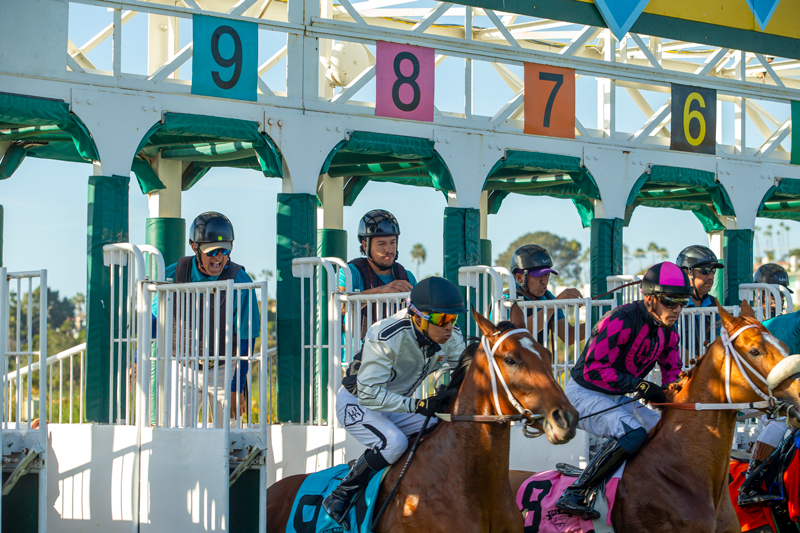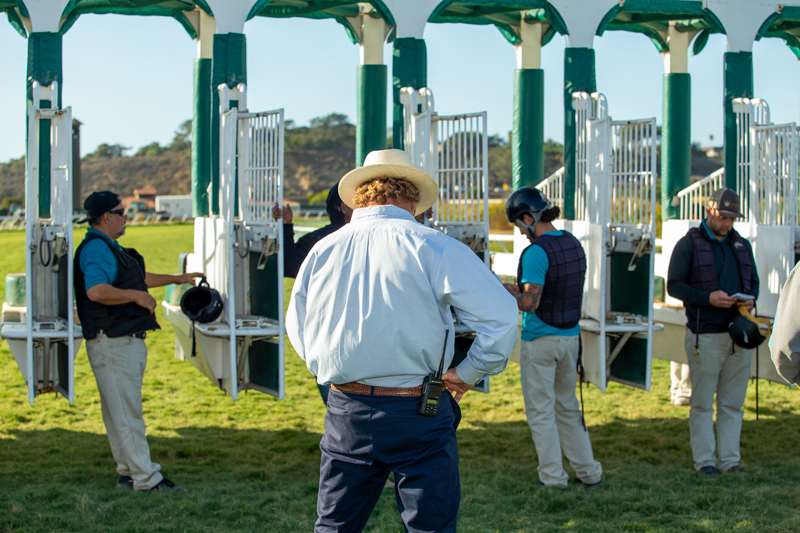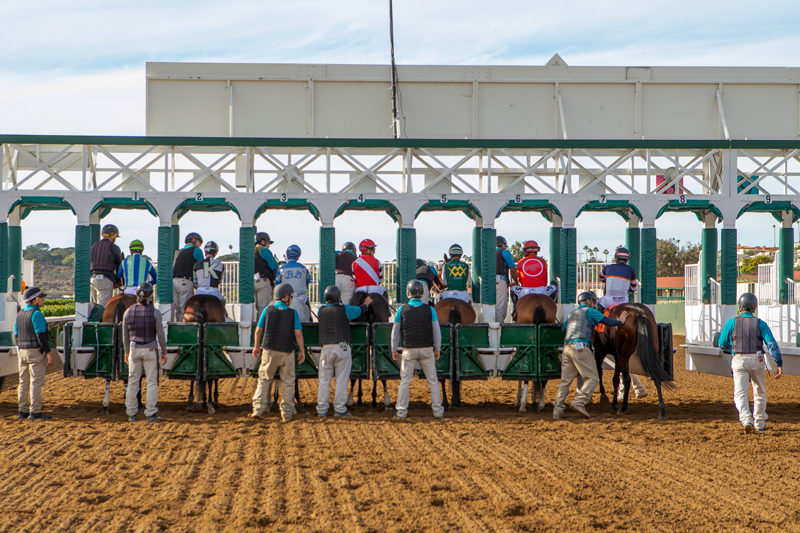By Jim Charvat

Head Starter Jay Slender (right) and his Gate Crew © Benoit Photo
It is arguably the most dangerous job in horse racing. Every race day a team of at least a dozen men follow the starting gate around the track to the starting points of each race. They are then tasked with making sure every horse and its rider get into and out of the gate safely and that each gets a fair start.
They’re called assistant starters. Once the horse is loaded and the doors are closed, assistant starters climb up into the gate, one for each horse. They don’t climb on the horse, that place is already taken. But rather stand alongside the horse on a small medal ledge in the gate about two feet off the ground. While perched on this ledge, he holds the horse in place and points him in the right direction. Once the gates pop open and the horse is away and running, the assistant starter’s job is done, for that race anyway.
Sounds easy. Except it’s not. Think about this for a second. An averaged sized man climbs into this small, cramped space (think phone booth size), with a thousand-pound animal that’s keyed-up and ready to run. What could possibly go wrong?
“Broken thumb, a few fingers,” says assistant starter Kiel Travis, a veteran of the racetrack for much of his life. He’s been working the gate for 36 years.
“I’ve been kicked in the gut and in the leg,” Travis says. “I have titanium in my neck right now.
“It happened a couple of years ago,” Travis continues. “I was packing a horse. (That’s when two assistant starters link their arms behind a horse to push it into the gate). The horse kicked up and broke our arms open. Kind of jerked me a little bit. I didn’t even think it happened but I got home and my neck got stiff. I went and had an MRI done and they found vertebrae seven down on the nerve. It just crushed it. I couldn’t even close my hand it was so bad.”
It was during Covid so Travis had to wait two months to get an operation, but he’s fine now.
“Broken fingers everywhere,” assistant starter Gilbert Valenzuela notes. “My shoulders are shot. My knees are bad.”
Valenzuela’s been doing this work for 34 years non-stop.
So why do they do it? Why risk life and limb?

Kicking It © Benoit Photo
“It’s a fun job,” Travis will tell you. “It’s exciting, you’re outside - are you kidding me. I’d be at the track anyway if I wasn’t doing this.”
“I think because of it (the danger),” assistant starter Kyle Lopez says, “and we get away with it.”
“There’s a big thrill,” Valenzuela adds, “and the love for the horses.”
Every effort is made to take the unexpected, the surprise, out of the job. For instance, in the mornings they school the horses. Trainers will bring their horses to the starting gate and the assistant starters will work with them to get them used to being loaded in the gate, and also what to do once the doors open.
“We start at 6:30,” Travis says. “We get between 45-to-55 horses. We back them in and out, the regular schooling thing. There are 2,000 horses in the book and we keep track of them every day. For every horse that comes through the gate we write a little note on what they do.
“Horses are just like people; they’re all different,” Travis continues. “You can’t treat them all the same. If you do, you’re going to land in some trouble. Like Queen of Pompeii (a local allowance mare). She’ll get to the gate and she won’t go in unless you open the doors in front of her. You open the doors in front, she’ll walk in. Other than that, she’ll fight you to go in.”
They learn Queen of Pompeii’s quirks in the morning so they don’t have to deal with them in the afternoon.
“It’s easier in the afternoon than in the morning because you’re teaching horses to behave in the morning,” Travis says. “In the afternoon it’s gravy.”
They also teach the younger horses how to break from the gate.
“In the mornings when these babies come up, these horses come up, we teach them how to be in the gate,” Valenzuela says. “We teach them how to come out of the gate. They come from ranches and every horse is at a different stage. Some horses don’t know anything, some don’t know how to come out. Then we start sending them in twos and threes so they start teaching each other. When they come out, they follow each other.”
“The first time we kick it (open the gate), they’re going to stand there most of the time,” Travis explains. “Sometimes you’ll open the door slowly, try to get them to follow the doors. Some horses are smarter than others, a lot smarter, and the first time they’ll do it. A horse like Beholder (the champion female); it doesn’t take them long, they’re smart.”
Part of the reason these men take on the job of assistant starter is their confidence in handling horses. Most of them have been around horses all their life, so they feel that, if a horse acts up in the gate, they know what to do.
“You just try to talk to them because they're creatures of habit, creatures of command,” Valenzuela says. “You tell them ‘Come here, back; Come here, back.’ Over a period of time, they understand what you’re asking of them. When I tell a horse to go back, I poke them in the chest a little bit with my fingers and then press back on the rein. I’ll stop them, pet them. The faster they know what you’re asking of them, the quicker and easier the job’s going to be.
“If you’re pushing a horse and he doesn’t know what you’re asking of him, be ready for a fight,” Valenzuela continues. “If they don’t know what you’re asking them, you have to teach them. They don’t know that by themselves.”
Valenzuela comes from a long line of horsemen.
“My uncles were all jockeys back in the ‘40s and ‘50s,” Valenzuela says. “My uncle, before he passed away, was inducted into the Hall of Fame. His name was Ismael Valenzuela. My cousin, Patrick Valenzuela, was one of the top jockeys here. My mom and his dad are brother and sister.
“I wanted to be a jockey,” Valenzuela continues. “But I’m the size of a football player, so I groomed horses for my uncles who were trainers, too. I tried to pony horses but that’s not why I got into the business. I like to be on the ground.“
“My father did it. He started here in 1976,” Lopez says. “I needed a job when I left high school. I was 18 and started schooling and worked my way up. When I started there was Hollywood, Santa Anita, Pomona and Del Mar. You’d just call for work or the bosses call and say: ‘We need you for the afternoon.’”
“My dad owned Quarter Horses in the ‘70s,” Travis adds, “and I got it in my blood. I wanted to be a jockey but I got too big and I like to eat. I like to be around horses, so I was a groom for a while and then seeing the guys in the starting gate, it looked fun and exciting.”

The Boss Deciding Who Gets Who © Benoit Photo
The process of loading the horses actually begins before they reach the gate. Official starter Jay Slender will bark out an assistant starter’s name and then a number. That’s the post position the assistant starter is assigned. He then refers to his program to see which horse he’s dealing with and whatever notes he’s written down about that horse.
Slender will assign the most “troublesome” horses to his strongest guys, which means Valenzuela and Travis are usually in the gate.
“I like to rub the corner of their eye (to keep them calm),” Travis says. “If he holds his head down, you can’t break like that so you’re trying to get his head up. All the horses are in (the gate) so you have to do something, so I’ll just cup an ear which is just like grabbing your elbow. It’s not a lot. You try to straighten their head a little bit for that split second and then Jay hits the button and they’re gone.”
“We used to bite a horse’s ears,” Travis continues. “But they say you can’t do that anymore. It’s nothing. You bite a horse’s ears it’s like your elbow, like I said. It doesn’t hurt. They just feel it for a second and then boom, they’re gone.”
So what does Travis do when he gets an unruly horse in the gate?
“I just grab their shoulder,” he explains. “Try to grab a muscle and squeeze it. Sometimes it gets their attention and they stand still. You’re trying to get their attention for a split second before they break. You just try to do your best to keep them in there. Sometimes it’s not easy. It’s a battle sometimes. And you know which ones they are because you see them every week.”
There are several proven techniques the assistant starters employ to coax a horse who, despite his schooling in the morning, may not want to load in the gate in the afternoon.

Last Horse Loading © Benoit Photo
“If they don’t come into the gate a lot of times we’ll pack them in,” Travis says. “Or we’ll crack a door in front. They’ll walk in and we’ll trap them. Packing them is a lot easier (than opening the front of the gate) because you don’t want them to bowl through the front. Sometimes they want to go all the way through. You try it in the morning to see how they’re going to react instead of doing it in the afternoon during the races so he’s not running down there with a jock who’s not as strong as a gallop boy.”
All of the assistant starters are equipped with a protective vest.
“It has saved me plenty of times,” Travis admits. “I have been pawed in the back a few times and if this (the vest) wasn’t on there it probably would have broke some ribs. “
Since 2008, the assistant starters all wear helmets. Bo Derek brought them in when she was a member of the CHRB.
“A horse hit me with his teeth,” Travis says referring to an incident from a while back. “Pretty Catherine was her name. You don’t forget horses who do stuff like that to you. It cut my head and when I took my hat off, blood was running out of head. If I had a helmet on, that wouldn’t have happened.”
Travis has been working at Del Mar since 2000. He provides veteran leadership and brings a vast amount of knowledge and experience to the team.
“You don’t always want to keep a horse pointed all the time either,” he notes. “Because then he’s always keen and you don’t want them like that. There are still four or five horses to load so I just kind of let them do what they want. Look around. I don’t point their head right when we get in the gate. They might do a false break and hit their head on the doors or breakthrough like they do on occasion.”
The team is made up of 12-to-14 assistant starters. Those who are not assigned a horse and don’t climb up in the gate, have an equally important job on the ground.
“If we’re not assigned a horse then you know your job is on the ground in the back,” Lopez says. “That way if something happens, you grab the rider and protect the horse. Back them out.”
Teamwork is the key. Everyone knowing their assignment and working together to get a clean break.
“You gotta holler ‘No, No, No’ if you’re not ready,” Travis explains. “Because if he (Slender) doesn’t hear anything he’s going to kick it and your horse is way over there if you’re not paying attention.”
So the next time you’re at the races take particular notice of those guys in the Del Mar teal vests working alongside the horses at the starting gate. It’s a show unto itself and an opportunity to see veteran horsemen at work.





